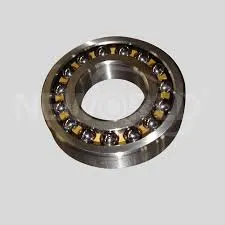
10 月 . 30, 2024 21:55 Back to list
deep groove ball bearing calculation
Understanding Deep Groove Ball Bearing Calculations
Deep groove ball bearings are among the most widely used types of rolling bearings. They are equipped with deep raceways, allowing them to accommodate radial and axial loads in both directions. Accurate calculations are essential for their design, selection, and application to ensure optimal performance and longevity. In this article, we will discuss the key aspects of deep groove ball bearing calculations, including load capacity, life expectancy, and other critical parameters.
Load Capacity
The load capacity of a deep groove ball bearing is a crucial factor in its design. There are primarily two types of load to consider radial load and axial load. Radial loads are perpendicular to the axis of rotation, while axial loads are parallel. The dynamic load rating (C) and static load rating (C0) are essential parameters specifying the limits under which the bearing can operate efficiently.
To calculate the equivalent radial load (P), the formula is as follows
\[ P = X \cdot F_r + Y \cdot F_a \]
Where - \( F_r \) is the radial load, - \( F_a \) is the axial load, - \( X \) and \( Y \) are factors dependent on the bearing's design, such as the raceway angle and bearing size.
These parameters help in assessing whether the bearing can support the intended loads without experiencing failure.
Life Expectancy
deep groove ball bearing calculation

The life expectancy of a deep groove ball bearing is vital information for engineers and designers. It can be estimated using the following formula
\[ L_{10} = \left( \frac{C}{P} \right)^3 \]
Where - \( L_{10} \) is the rating life in millions of revolutions, - \( C \) is the dynamic load rating, - \( P \) is the equivalent radial load.
This formula indicates that as the load increases, the bearing life decreases significantly. It is important to select bearings with an appropriate load rating to ensure they meet the specific performance requirements.
Factors Affecting Bearing Performance
Several additional factors can influence the performance and longevity of deep groove ball bearings. These include lubrication, operating temperature, and the presence of contaminants. Maintaining proper lubrication is critical, as it reduces friction and wear, while the operating environment should be monitored to prevent dust and moisture ingress, which can introduce premature failures.
Conclusion
Deep groove ball bearings play a critical role in various mechanical applications. The accuracy of their calculations—whether for load capacity, life expectancy, or other factors—directly affects their efficiency and durability. By utilizing the appropriate mathematical frameworks, engineers and designers can ensure that the selected bearings will perform optimally under specified conditions, ultimately leading to improved reliability and reduced maintenance costs.
Latest news
-
Unlocking Efficiency with Spherical Roller Bearings
NewsOct.29,2024
-
The Ultimate Guide to Thrust Ball Bearings
NewsOct.29,2024
-
The Power of Thrust Roller Bearings: Engineered for Excellence
NewsOct.29,2024
-
The Power of Deep Groove Ball Bearings for Your Application Needs!
NewsOct.29,2024
-
The Power and Performance of Cylindrical Roller Bearings
NewsOct.29,2024
-
High-Quality Ball Bearing Manufacturing Machines
NewsOct.29,2024
